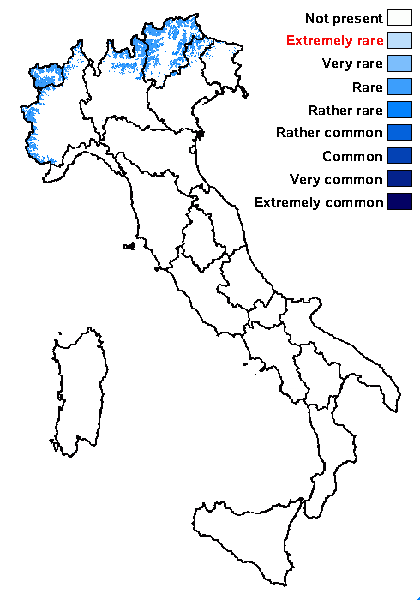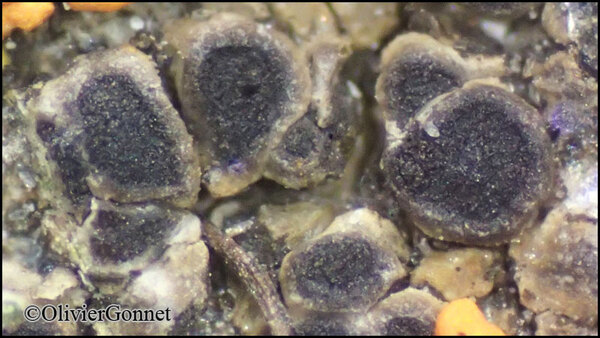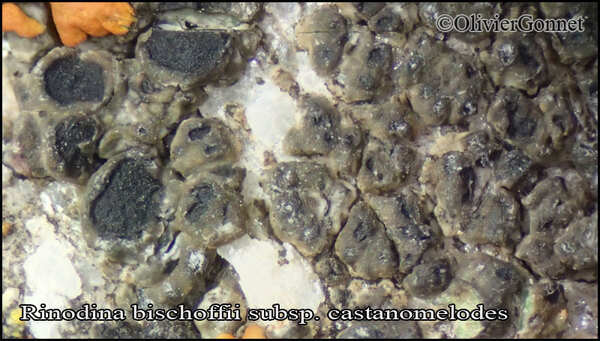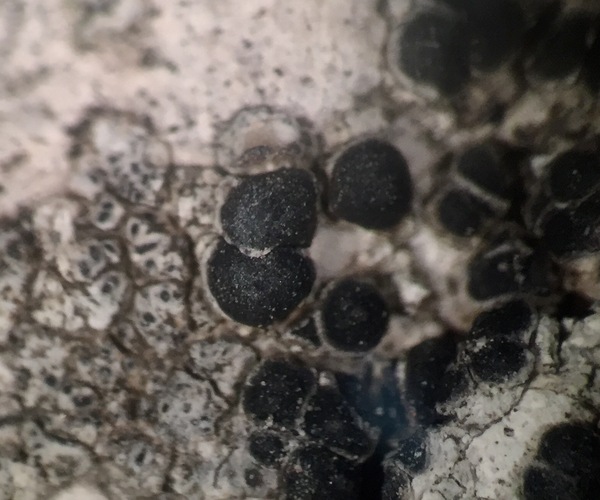Rinodina castanomelodes H. Mayrhofer & Poelt
Bibl. Lichenol., 12: 81, 1979.
Synonyms: Oxnerella castanomelodes (H. Mayrhofer & Poelt) S.Y. Kondr., Lőkös & Hur; Rinodina bischoffii var. castanomelodes (H. Mayrhofer & Poelt) Giralt & Llimona; Rinodina orcularia H. Mayrhofer & Poelt
Distribution: N - Frl (Nascimbene & al. 2021), Ven (Nimis 1994), TAA (Nascimbene & al. 2022), Lomb, Piem (TSB 34209), VA (Piervittori & Isocrono 1999). S - Bas.
Description: Thallus crustose, episubstratic, rather thick, grey-brown to dark brown (damaged specimens often paler), rimose-areolate, sometimes reduced to a few warts surrounding the apothecia; areoles convex, the peripheral ones subsquamulose, ecorticate, with an epinecral layer. Apothecia lecanorine, 0.3-0.6 mm across, at first slightly immersed, then subsessile, often crowded and deformed by mutual compression, with a concave to slightly convex, black disc, a thick thalline margin, and a usually visible parathecial ring. Epithecium dark brown, K-; hymenium colourless, inspersed with oil droplets, 100-120 µm high; paraphyses 2-2.5 µm thick at mid-level, the apical cells swollen, 6-8 µm wide; hypothecium colourless, up to 150 µm high. Asci 8-spored, clavate, the K/I+ blue tholus penetrated by a faintly amyloid apical cushion with parallel or diverging flanks, the wall K/I-, surrounded by a K/I+ blue outer layer, Lecanora-type. Ascospores 1-septate, brown, ellipsoid, (16-)18-20(-21) . (9.5-)11-12(-13) µm, Bischoffii-type, with a broad pigmented band around septum, the torus not developed, the ontogeny of type A (apical wall thickening after septum formation). Photobiont chlorococcoid. Spot tests: K-, C-, KC-, P-, UV-. Chemistry: without lichen substances.Note: an arctic-alpine to boreal-montane, perhaps circumpolar lichen found on limestone, marl and calcareous schists in and above treeline; widespread but not common in the Alps, where it can reach the nival belt, and also reported from the mountains of Southern Italy.
Growth form: Crustose
Substrata: rocks
Photobiont: green algae other than Trentepohlia
Reproductive strategy: mainly sexual
Commonnes-rarity: (info)
Alpine belt: rare
Subalpine belt: rather rare
Oromediterranean belt: very rare
Montane belt: very rare
Submediterranean belt: absent
Padanian area: absent
Humid submediterranean belt: absent
Humid mediterranean belt: absent
Dry mediterranean belt: absent

Predictive model
Herbarium samples

Courtesy Danièle et Olivier Gonnet - Source: https://www.afl-lichenologie.fr/Photos_AFL/Photos_AFL_R/Rinodina_bischoffii_cast.htm
France, 2013 - Mont Cenis, alt. 2000 m - Savoie

Courtesy Danièle et Olivier Gonnet - Source: https://www.afl-lichenologie.fr/Photos_AFL/Photos_AFL_R/Rinodina_bischoffii_cast.htm
France, 2013 - Mont Cenis, alt. 2000 m - Savoie
Growth form: Crustose
Substrata: rocks
Photobiont: green algae other than Trentepohlia
Reproductive strategy: mainly sexual
Commonnes-rarity: (info)
Alpine belt: rare
Subalpine belt: rather rare
Oromediterranean belt: very rare
Montane belt: very rare
Submediterranean belt: absent
Padanian area: absent
Humid submediterranean belt: absent
Humid mediterranean belt: absent
Dry mediterranean belt: absent

Predictive model
| Herbarium samples |

Courtesy Danièle et Olivier Gonnet - Source: https://www.afl-lichenologie.fr/Photos_AFL/Photos_AFL_R/Rinodina_bischoffii_cast.htm
France, 2013 - Mont Cenis, alt. 2000 m - Savoie

 Index Fungorum
Index Fungorum
 GBIF
GBIF




